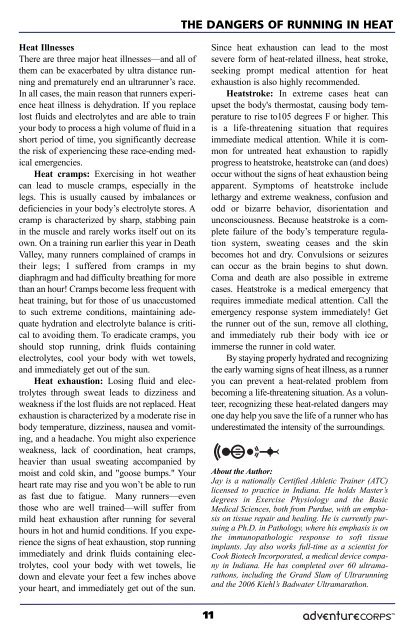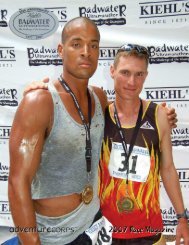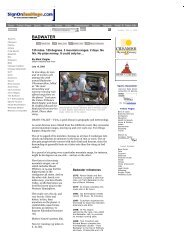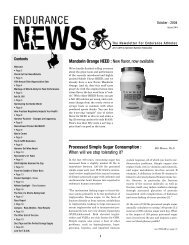Race Magazine - AdventureCORPS
Race Magazine - AdventureCORPS
Race Magazine - AdventureCORPS
You also want an ePaper? Increase the reach of your titles
YUMPU automatically turns print PDFs into web optimized ePapers that Google loves.
THE DANGERS OF RUNNING IN HEAT<br />
Heat Illnesses<br />
There are three major heat illnesses—and all of<br />
them can be exacerbated by ultra distance running<br />
and prematurely end an ultrarunner’s race.<br />
In all cases, the main reason that runners experience<br />
heat illness is dehydration. If you replace<br />
lost fluids and electrolytes and are able to train<br />
your body to process a high volume of fluid in a<br />
short period of time, you significantly decrease<br />
the risk of experiencing these race-ending medical<br />
emergencies.<br />
Heat cramps: Exercising in hot weather<br />
can lead to muscle cramps, especially in the<br />
legs. This is usually caused by imbalances or<br />
deficiencies in your body’s electrolyte stores. A<br />
cramp is characterized by sharp, stabbing pain<br />
in the muscle and rarely works itself out on its<br />
own. On a training run earlier this year in Death<br />
Valley, many runners complained of cramps in<br />
their legs; I suffered from cramps in my<br />
diaphragm and had difficulty breathing for more<br />
than an hour! Cramps become less frequent with<br />
heat training, but for those of us unaccustomed<br />
to such extreme conditions, maintaining adequate<br />
hydration and electrolyte balance is critical<br />
to avoiding them. To eradicate cramps, you<br />
should stop running, drink fluids containing<br />
electrolytes, cool your body with wet towels,<br />
and immediately get out of the sun.<br />
Heat exhaustion: Losing fluid and electrolytes<br />
through sweat leads to dizziness and<br />
weakness if the lost fluids are not replaced. Heat<br />
exhaustion is characterized by a moderate rise in<br />
body temperature, dizziness, nausea and vomiting,<br />
and a headache. You might also experience<br />
weakness, lack of coordination, heat cramps,<br />
heavier than usual sweating accompanied by<br />
moist and cold skin, and "goose bumps." Your<br />
heart rate may rise and you won’t be able to run<br />
as fast due to fatigue. Many runners—even<br />
those who are well trained—will suffer from<br />
mild heat exhaustion after running for several<br />
hours in hot and humid conditions. If you experience<br />
the signs of heat exhaustion, stop running<br />
immediately and drink fluids containing electrolytes,<br />
cool your body with wet towels, lie<br />
down and elevate your feet a few inches above<br />
your heart, and immediately get out of the sun.<br />
Since heat exhaustion can lead to the most<br />
severe form of heat-related illness, heat stroke,<br />
seeking prompt medical attention for heat<br />
exhaustion is also highly recommended.<br />
Heatstroke: In extreme cases heat can<br />
upset the body's thermostat, causing body temperature<br />
to rise to105 degrees F or higher. This<br />
is a life-threatening situation that requires<br />
immediate medical attention. While it is common<br />
for untreated heat exhaustion to rapidly<br />
progress to heatstroke, heatstroke can (and does)<br />
occur without the signs of heat exhaustion being<br />
apparent. Symptoms of heatstroke include<br />
lethargy and extreme weakness, confusion and<br />
odd or bizarre behavior, disorientation and<br />
unconsciousness. Because heatstroke is a complete<br />
failure of the body’s temperature regulation<br />
system, sweating ceases and the skin<br />
becomes hot and dry. Convulsions or seizures<br />
can occur as the brain begins to shut down.<br />
Coma and death are also possible in extreme<br />
cases. Heatstroke is a medical emergency that<br />
requires immediate medical attention. Call the<br />
emergency response system immediately! Get<br />
the runner out of the sun, remove all clothing,<br />
and immediately rub their body with ice or<br />
immerse the runner in cold water.<br />
By staying properly hydrated and recognizing<br />
the early warning signs of heat illness, as a runner<br />
you can prevent a heat-related problem from<br />
becoming a life-threatening situation. As a volunteer,<br />
recognizing these heat-related dangers may<br />
one day help you save the life of a runner who has<br />
underestimated the intensity of the surroundings.<br />
About the Author:<br />
Jay is a nationally Certified Athletic Trainer (ATC)<br />
licensed to practice in Indiana. He holds Master’s<br />
degrees in Exercise Physiology and the Basic<br />
Medical Sciences, both from Purdue, with an emphasis<br />
on tissue repair and healing. He is currently pursuing<br />
a Ph.D. in Pathology, where his emphasis is on<br />
the immunopathologic response to soft tissue<br />
implants. Jay also works full-time as a scientist for<br />
Cook Biotech Incorporated, a medical device company<br />
in Indiana. He has completed over 60 ultramarathons,<br />
including the Grand Slam of Ultrarunning<br />
and the 2006 Kiehl’s Badwater Ultramarathon.<br />
11
















